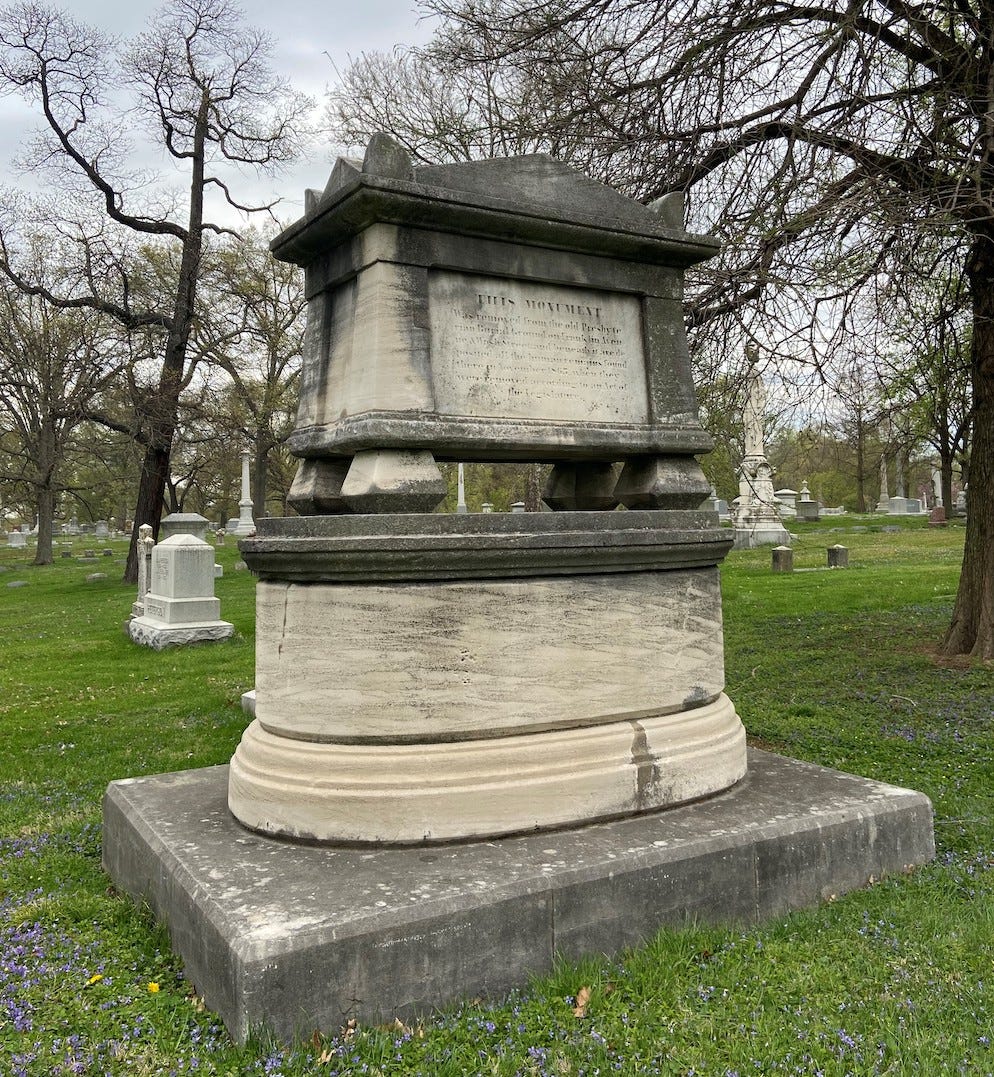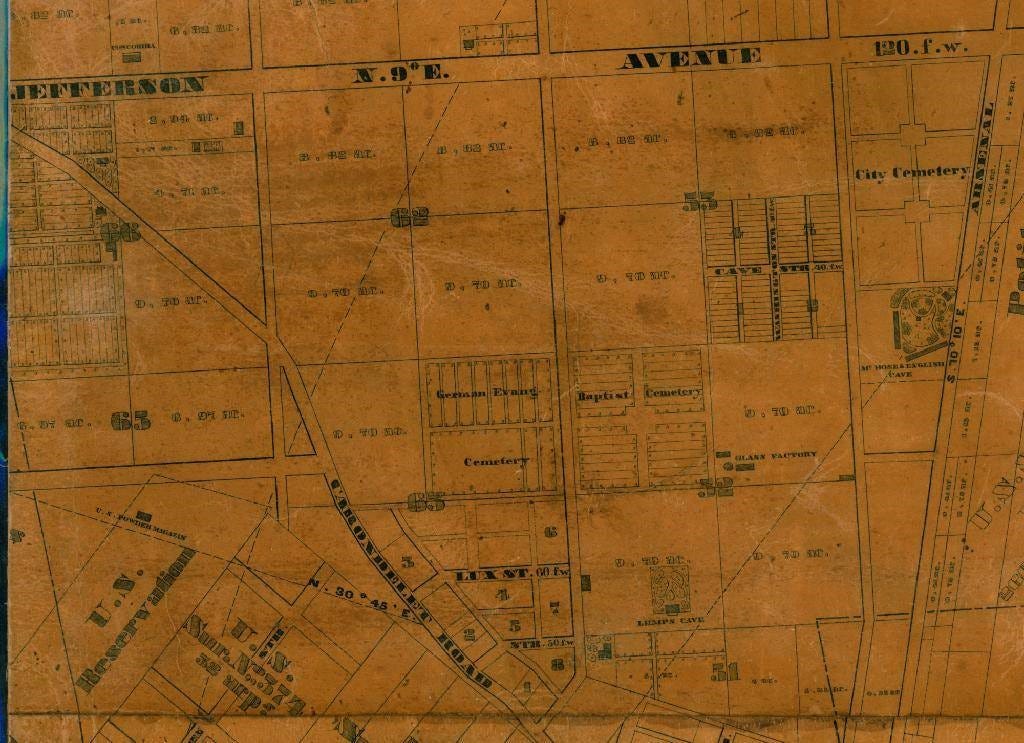Going 'beyond the grave' in St. Louis
Explore the history of cemeteries, cremation, and body snatching in the city
For this special edition of Unseen St. Louis, I interviewed Amanda Clark, Community Tours Manager for the Missouri Historical Society. After meeting Amanda on a tour last spring, I discovered that we share an unquenchable curiosity for lesser-known aspects of St. Louis history. I thought it would be fun to learn a little about her and why she loves local history so much, as well as spread the word about her upcoming tours.
Amanda Clark wants to talk to you about death.
More specifically, she’s leading a local tour that explores how people in St. Louis have viewed the process of death and dealing with the dead over the centuries, and how perceptions have changed over the years.

Amanda, once the owner of Renegade STL tours, now works full-time as the Community Tours Manager for the Missouri Historical Society, leading See STL, a series of public tours focusing on unusual aspects of St. Louis history. As she’s quick to point out, her tours are less about tourism and instead delve into lesser-appreciated aspects of the city’s past.
After moving to St. Louis from Tennessee, Amanda stumbled across the city’s complicated past after learning about how in the 19th and early 20th centuries the area’s mounds and sacred sites were unceremoniously pushed into the river or used for fill. Wanting to share her new passion for local history with others, she started as a volunteer tour guide. She soon recognized the need for more diverse tours (and wider representation among tour guides), and in 2011 she started up her own tour company. In 2020 she joined forces with the Missouri Historical Society to create a new series of local history tours, and that’s when See STL was born.
Her newest offering, ‘Beyond the Grave,’ is a two-hour bus tour that visits sites of cemeteries (including those that no longer exist) and other sites related to death and dying in the city. Her focus isn’t on ghosts or the macabre, but instead, Amanda wants to address a topic that has helped to shape the city over time. (See below for details).
A fascination with James Buchanan Eads and his bridge
Before we discussed her latest tour, I wanted to learn a little more about Amanda through her favorite local history topic: James Eads and the construction of the Eads Bridge.
Amanda finds herself drawn to the story of the bridge and the man behind its construction because, like so many things, it’s a complex tale. She told me the story of Eads forming the St. Louis Bridge and Tunnel Company. Because of the politics between Illinois and Missouri, Eads could build his bridge in only one place, right along the downtown riverfront. This limitation was an attempt by Illinois to shut down the project, because the state knew St. Louis didn’t want trains running right through the center of downtown St. Louis (which by the mid-1860s was a bustling city).
Other men might have given up at that point, but not Eads. He formed his company to figure out a way to build that bridge. Along the way, his team had to research the geology, map out routes, negotiate with landowners to get permission to dig under buildings, and ultimately bribe local officials, in order to get the bridge approved. And that was all before one shovel ever broke ground.
For Amanda, Eads and his bridge “epitomize St. Louis.” As she pointed out,
“How many St. Louisans don’t realize we have this incredible piece of history downtown? They don’t drive across it, they don’t realize that if the Arch hadn’t been built, that bridge would be our big engineering marvel. So it symbolizes St. Louis to me, where there is so much more [to the story.]”
But Amanda is intrigued by more than just the bridge. She explained that Eads himself was fascinating. He came up with the idea for big engineering projects, and saw them through—including designing ironclads, opening the Port of New Orleans to ocean traffic, and, just before he died, working on a way to put a ship on a railroad to carry it across Mexico (this was before the Panama Canal).
Apparently, scholars have nothing bad to say about Eads—as Amanda tells it, he didn’t own slaves, and there are no records of him treating people poorly. “While he wasn’t perfect,” she noted, “he’s a rare guy in history that seems to be pretty decent.” And when he died, his last words were, “I can’t die now, my work isn’t finished.”
For more on this topic, check out Amanda’s presentation on James Eads from 2020.
Why do a tour about death and dying?
Over the years many people asked Amanda to do cemetery tours, true crime tours, or haunted St. Louis tours, but for her, there was always something missing from those types of tours.
Instead, with her newest tour, she wants to explore the reasons why all of those topics are so popular—and what drives the modern fascination with death.
On the ‘Beyond the Grave’ tour, Amanda plans to describe how people’s changing relationship with death, starting in 1849 and running up to the present day, shows up in the built environment of the city. For example, she will explain how, as the city grew over the years, officials had to push graveyards further and further out. She will also examine questions of death and disease, and in particular how the bodies of the poorest residents were handled.
And then she’ll discuss the unsettling topic of body snatching, a problem that we can’t fathom today but which was a huge issue back in the 19th century. Because of the rise of medical colleges in the St. Louis area, bodies used to be in high demand for anatomy classes and experimentation. Furthermore, body snatching was a class thing, and generally only happened to the poor. If a family had a loved one’s body go missing, that reflected badly on the surviving members of the family. To avoid tarnishing their reputation, some families resorted to disinterring a relative just to prove that the body had not been tampered with.

And while digging up corpses seems abhorrent to us today, the fact is that access to these bodies helped advance medical science and inspired artists. One such artist was female sculptor Harriet Hosmer, who came to St. Louis 1850 to study at one of those medical colleges that utilized stolen corpses.
On her tour, Amanda also will talk about cremation, and how St. Louis was the first city west of the Mississippi where people could be cremated.
Her goal with this tour is to create a space where we can talk about death without being afraid of it.
Sign up for the ‘Beyond the Grave’ tour
Whether you’re a history buff or just want to learn a little more about your hometown, Amanda’s tours will entertain, educate, and even surprise you. The bus tours are on comfortable air-conditioned tour buses that meander through off-the-beaten-path areas of the city.
There are two three! scheduled ‘Beyond the Grave’ tours. Both take place on Saturdays from 11 AM – 1 PM. If you want to grab a spot, you can sign up by clicking on the dates below (subject to availability).
Where can you find Amanda?
Amanda organizes See STL, an ongoing series of local history tours led by herself and other guides (these include both bus and walking tours).
In addition to her tours, she gives occasional presentations on history topics at the Missouri History Museum and local sites including the Museum of Transportation, and once a month does a Missouri history takeover tour on the St. Louis Riverfront Cruises. The See STL tours are also available as private group tours in St. Louis.
[Edit: in the original version of this post I referred to Eads as Robert, rather than James, Eads. Amanda kindly reminded me of his correct name. I sincerely regret my brain fart.]









Another newsletter, another interesting piece about St. Louis. Thanks, Jackie!